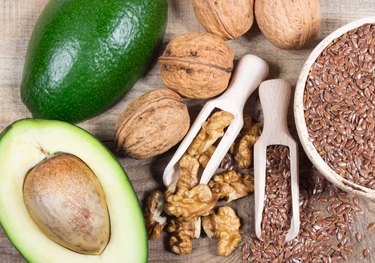
When you consume more calories than your body needs, both carbs and fats end up stored in muscles and in other areas throughout the body. The body stores dietary fats in the form of triglycerides, whether in muscles or fat cells.
Carbs are first turned into glycogen, which is stored in the liver and muscles. When the limited storage space for glycogen is full, the liver converts extra carbs into triglycerides and sends them through the body where they accumulate in fat cells until you need energy.
Video of the Day
Video of the Day
Tip
Your body stores fat as a back-up energy source to carbohydrates. Excess amounts are stored in fat cells.
Read more: 12 Habits That Could Be Making You Gain Fat
Storage of Dietary Fats and Carbs
Even though they're made from different substances — carbs contain units of sugar, while fats consist of glycerol and fatty acids — both macronutrients can be used for energy. The body prefers to use carbs as a primary source of energy and dietary fats as a back-up, but fats typically provide more than half of the body's energy. When you consume more calories than the body burns, both macronutrients can be stored as fat in the form of triglycerides.
The body primarily stores triglycerides in fat cells called adipocytes, which expand to hold excess fat, but they have a limit. When they can't take in more triglycerides, the body synthesizes new fat cells. This creates seemingly endless space for fat storage, whether it originated as dietary fats or carbs.
Of course, fat cells release their stored triglycerides to provide energy when it's needed. Meanwhile, they function as more than fat storage bins because they produce hormones that help regulate appetite and metabolism.
Read more: Why You Need to Eat Fat to Burn Fat
Fats and Carbs in Muscles
The fats and carbs you eat share something else in common; they're both stored in small amounts in muscles, where they stand ready to provide energy when muscle activity increases. But this is different from storage in adipocytes — fat cells — because each macronutrient is stored in a different form.
Carbs are turned into glycogen, then stored in muscles, where it provides energy as needed. Glycogen is also stored in the liver, where it's a storage depot that's released into the bloodstream when levels of blood glucose fall too low.
Dietary fats stored in muscles stay in the form of triglycerides. Muscles throughout the body can store a total of about 300 grams of fat and 350 grams of glycogen. Exercise, diet and body weight influence glycogen storage, so trained athletes may have up to 700 grams of glycogen stored in their muscles, according to the December 2015 issue of Nutrition and Metabolism.
Glycogen and triglycerides are used differently during exercise, depending on intensity. During low-intensity activities, muscles get their energy from fats delivered via the bloodstream. As exercise increases to a moderate intensity, fats stored in the muscles be the main source of energy. High-intensity activity burns carbohydrates, first using stores of glycogen in muscles, then relying on glucose from the bloodstream.
Food and Fat Cells
The total amount of fat stored in adipocytes, whether originally from dietary fats or carbs, is determined by the number of calories you eat. Certain types of carbs and fats can influence fat storage, however.
Simple carbohydrates from processed foods such as white rice and white flour, and foods with added sugar, have a higher chance of increasing fat storage. These carbs trigger the release of insulin, which has a "fat-sparing effect" in the body. In other words, insulin and fat storage are related — when levels of insulin are high, more glucose is sent to the liver to be turned into triglycerides and fat cells hold onto their stored fat so it's not used for energy.
One study published in Diabetes in February 2014 reported that eating saturated fat promoted visceral, or abdominal fat storage, while polyunsaturated fats were associated with an increase in lean muscle tissue.
Another study published in the European Journal of Nutrition in April 2014 also reported that saturated fats contributed to weight gain, while unsaturated fats didn't. More research is needed to verify these results, but they tend to support the benefit of consuming heart-healthy unsaturated fats from nuts, seeds, avocados and vegetable oils.
Subcutaneous and Visceral Fat
When carbs and dietary fat are stored in adipocytes as triglycerides, they tend to accumulate in two places — as subcutaneous fat and visceral fat. Subcutaneous fat is found under the skin, while visceral fat collects within the abdomen in the spaces around organs.
Any type of stored fat is dangerous because it increases your risk of developing health problems, including heart disease, diabetes, high blood pressure and sleep apnea. However, subcutaneous fat releases the beneficial hormones leptin and adiponectin, while visceral fat promotes inflammation, reports the Harvard Medical School.
Your genes, age and hormones determine where you store fat. The Harvard article says that visceral fat is often easier to lose than fat on the hips and thighs because it responds better to diet and exercise. Regular exercise — 30 minutes of moderate activity most days — can trim your waist, although you may not lose weight as you gain muscle while losing fat.
Getting a balanced diet with just the right number of calories is critical. Also be sure to avoid trans fats and fructose-sweetened products because they promote belly fat.
- Nutrition and Metabolism: "Glycogen Availability and Skeletal Muscle Adaptations with Endurance and Resistance Exercise"
- Diabetes: "Overfeeding Polyunsaturated and Saturated Fat Causes Distinct Effects on Liver and Visceral Fat Accumulation in Humans"
- European Journal of Nutrition: "Effect of Dietary Fatty Acid Composition on Substrate Utilization and Body Weight Maintenance in Humans"
- Harvard Medical School: "Taking Aim at Belly Fat"